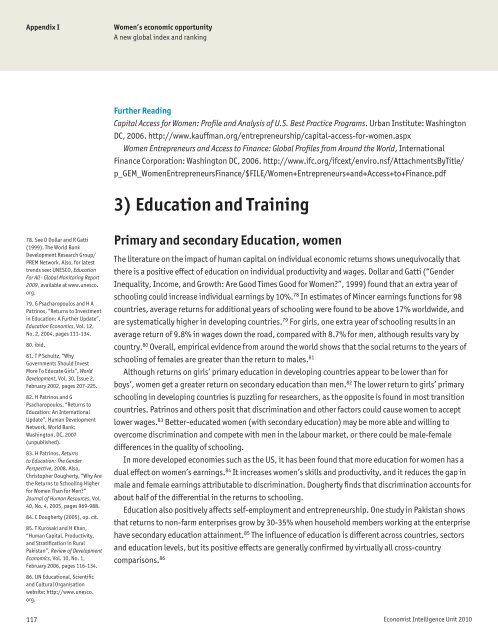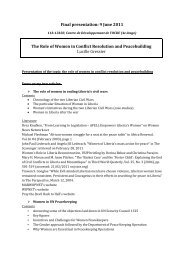Women's Economic Opportunity Index - Economist Intelligence Unit
Women's Economic Opportunity Index - Economist Intelligence Unit
Women's Economic Opportunity Index - Economist Intelligence Unit
- No tags were found...
Create successful ePaper yourself
Turn your PDF publications into a flip-book with our unique Google optimized e-Paper software.
Appendix IWomen’s economic opportunityA new global index and rankingFurther ReadingCapital Access for Women: Profile and Analysis of U.S. Best Practice Programs. Urban Institute: WashingtonDC, 2006. http://www.kauffman.org/entrepreneurship/capital-access-for-women.aspxWomen Entrepreneurs and Access to Finance: Global Profiles from Around the World, InternationalFinance Corporation: Washington DC, 2006. http://www.ifc.org/ifcext/enviro.nsf/AttachmentsByTitle/p_GEM_WomenEntrepreneursFinance/$FILE/Women+Entrepreneurs+and+Access+to+Finance.pdf3) Education and Training78. See D Dollar and R Gatti(1999). The World BankDevelopment Research Group/PREM Network. Also, for latesttrends see: UNESCO, EducationFor All - Global Monitoring Report2009, available at www.unesco.org.79. G Psacharopoulos and H APatrinos, “Returns to Investmentin Education: A Further Update”,Education <strong>Economic</strong>s, Vol. 12,No. 2, 2004, pages 111-134.80. ibid.81. T P Schultz, “WhyGovernments Should InvestMore To Educate Girls”, WorldDevelopment, Vol. 30, Issue 2,February 2002, pages 207-225.82. H Patrinos and GPsacharopoulos, “Returns toEducation: An InternationalUpdate”, Human DevelopmentNetwork, World Bank:Washington, DC, 2007(unpublished).83. H Patrinos, Returnsto Education: The GenderPerspective, 2008. Also,Christopher Dougherty, “Why Arethe Returns to Schooling Higherfor Women Than for Men?”Journal of Human Resources, Vol.40, No. 4, 2005, pages 969-988.84. C Dougherty (2005), op. cit.85. T Kurosaki and H Khan,“Human Capital, Productivity,and Stratification in RuralPakistan”, Review of Development<strong>Economic</strong>s, Vol. 10, No. 1,February 2006, pages 116-134.86. UN Educational, Scientificand Cultural Organisationwebsite: http://www.unesco.org.Primary and secondary Education, womenThe literature on the impact of human capital on individual economic returns shows unequivocally thatthere is a positive effect of education on individual productivity and wages. Dollar and Gatti (“GenderInequality, Income, and Growth: Are Good Times Good for Women?”, 1999) found that an extra year ofschooling could increase individual earnings by 10%. 78 In estimates of Mincer earnings functions for 98countries, average returns for additional years of schooling were found to be above 17% worldwide, andare systematically higher in developing countries. 79 For girls, one extra year of schooling results in anaverage return of 9.8% in wages down the road, compared with 8.7% for men, although results vary bycountry. 80 Overall, empirical evidence from around the world shows that the social returns to the years ofschooling of females are greater than the return to males. 81Although returns on girls’ primary education in developing countries appear to be lower than forboys’, women get a greater return on secondary education than men. 82 The lower return to girls’ primaryschooling in developing countries is puzzling for researchers, as the opposite is found in most transitioncountries. Patrinos and others posit that discrimination and other factors could cause women to acceptlower wages. 83 Better-educated women (with secondary education) may be more able and willing toovercome discrimination and compete with men in the labour market, or there could be male-femaledifferences in the quality of schooling.In more developed economies such as the US, it has been found that more education for women has adual effect on women’s earnings. 84 It increases women’s skills and productivity, and it reduces the gap inmale and female earnings attributable to discrimination. Dougherty finds that discrimination accounts forabout half of the differential in the returns to schooling.Education also positively affects self-employment and entrepreneurship. One study in Pakistan showsthat returns to non-farm enterprises grow by 30-35% when household members working at the enterprisehave secondary education attainment. 85 The influence of education is different across countries, sectorsand education levels, but its positive effects are generally confirmed by virtually all cross-countrycomparisons. 86117 <strong>Economist</strong> <strong>Intelligence</strong> <strong>Unit</strong> 2010




